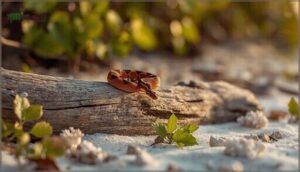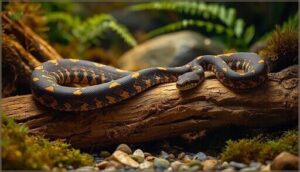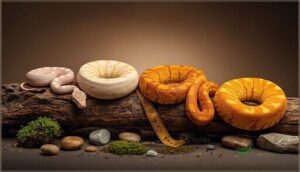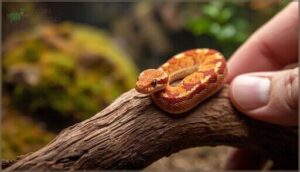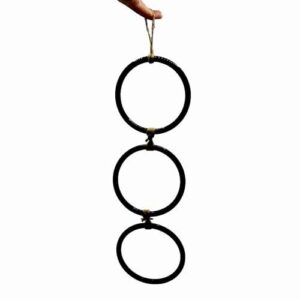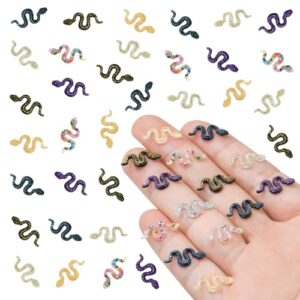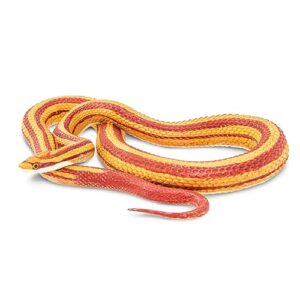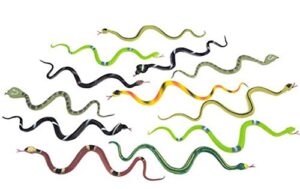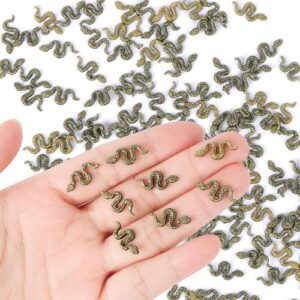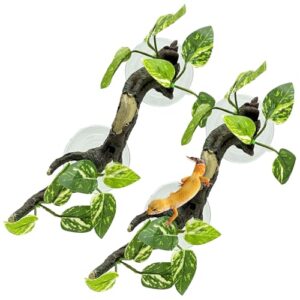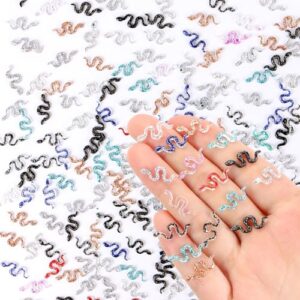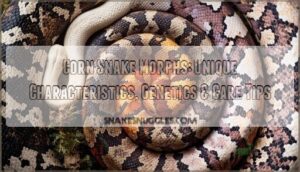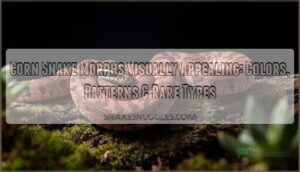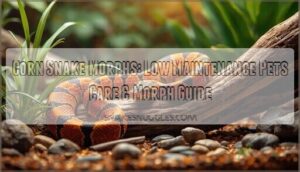This site is supported by our readers. We may earn a commission, at no cost to you, if you purchase through links.
You’ve probably seen those impressive four-foot corn snakes at expos and wondered if you could keep one without needing a furniture-sized enclosure. Here’s something most keepers don’t realize: certain corn snake morphs and locality lines stay considerably smaller than the standard 4-5 foot adults, topping out closer to the 2-3 foot range.
Keys locality snakes, for instance, rarely exceed 35 inches even at full maturity—a trait linked to island dwarfism in their wild ancestors. These compact morphs aren’t just convenient for tight spaces; they also require less feeding, produce smaller waste, and adapt well to modest setups.
Understanding which genetic lines and locality influences contribute to smaller adult sizes helps you choose a snake that fits both your space and husbandry preferences.
Table Of Contents
- Key Takeaways
- What Are Corn Snake Morphs That Stay Small?
- Smallest Corn Snake Morphs and Localities
- Popular Small Corn Snake Morphs Explained
- Physical and Behavioral Traits of Small Morphs
- Care Requirements for Small Corn Snake Morphs
- Ethical and Breeding Considerations
- Top 10 Corn Snake Products for Small Morphs
- 1. Playful Orange Corn Snake Stuffed Animal
- 2. Snake Enrichment Climbing Rings for Reptiles
- 3. Colorful Mini Resin Snakes Tiny Figurines
- 4. Safari Ltd Corn Snake Figurine Toy
- 5. Rhode Island Novelty Rain Forest Snakes
- 6. Aurora Playful Red Corn Snake Plush
- 7. Halloween Mini Snakes Resin Figurines
- 8. Fhiny Reptile Climbing Branch with Suction
- 9. Realistic Plastic Snakes Colorful Party Favors
- 10. Tiny Colorful Resin Snake Miniatures
- Frequently Asked Questions (FAQs)
- Conclusion
Key Takeaways
- Keys locality corn snakes stay smallest due to island dwarfism, typically maxing out at 24-35 inches instead of the standard 4-5 feet, making them ideal for tight spaces and requiring less feeding.
- Cinder morphs and their derivatives reach 43-59 inches with slimmer builds, while Microscale variants cap around 27.5-31.5 inches—all significantly smaller than typical corn snakes without major health trade-offs.
- Genetic lineage and locality influence adult size far more than feeding schedules or enclosure dimensions, so choosing the right morph upfront matters more than husbandry adjustments.
- Small morphs don’t require fundamentally different care beyond appropriately sized prey and modest enclosures, though ethical sourcing from transparent breeders prevents health issues linked to poor genetics.
What Are Corn Snake Morphs That Stay Small?
When you’re shopping for a corn snake, you might hear breeders throw around the term “morph” like it’s second nature. A morph is simply a corn snake with specific genetic traits that affect its color, pattern, or physical characteristics—think of it like different breeds of dogs, but for snakes.
Understanding what influences size in these morphs helps you pick the right snake for your space and experience level.
Definition of “morph” in Corn Snakes
A morph in corn snakes refers to a genetic mutation that changes the snake’s color, pattern, or both from the wild type appearance. These visual traits result from naturally occurring or selectively bred mutations affecting pigmentation.
Breeders use morph terminology to identify and combine specific genetic traits, creating hundreds of recognized corn snake morphs with unique color variations and patterns. Some morphs, like Anery and Amel, are popular among breeders.
Factors Influencing Adult Size in Morphs
While morph mutations affect appearance, several factors determine how large your corn snake will actually grow. Genetic influence from parent size and locality plays the biggest role—Keys lineage snakes, for instance, stay consistently smaller. Diet impact matters too: proper feeding schedules support healthy growth, while overfeeding causes weight gain without length.
Corn snakes are strict carnivores, primarily consuming small rodents, birds, and lizards. Enclosure size, sexual dimorphism, and activity factors also shape adult dimensions.
Genetics and Locality Impact on Size
Beyond basic feeding and housing, genetic lineage and locality influence determine your snake’s final size far more than you might expect. Corn snake genetics work through inheritance—hatchling size, growth rate, and adult body mass all trace back to parental lines and regional origin. Island dwarfism shapes Keys morphs, while genetic diversity varies widely across localities.
Here’s what morph genetics actually control:
- Adult length potential – Keys average under 90 cm; Okeetee exceed 120 cm
- Body mass at maturity – Small morphs plateau at 150–250 grams vs. standard 300–500 grams
- Hatchling size range – Keys emerge at 20–25 cm; larger localities start at 28–35 cm
- Growth rate speed – Smaller-morph juveniles mature faster despite slower growth
- Body width and build – Locality influence affects slenderness independent of length
Smallest Corn Snake Morphs and Localities
Not all corn snakes grow to the same size, and certain morphs are known for staying noticeably smaller than the standard 4 to 5 feet. If you’re looking for a more compact snake, understanding which localities and morphs tend to remain petite can help you make an informed choice.
Let’s look at the specific lineages and morphs that consistently produce smaller adults.
Keys Locality and Its Influence on Size
Keys genetics from the Florida Keys produce some of the smallest corn snake morphs you’ll find. Island dwarfism in snakes happens when island ecosystem constraints naturally select for smaller adults—Keys corn snakes usually max out around 24–35 inches.
Keys corn snakes from the Florida Keys stay smallest due to island dwarfism, typically maxing out at 24–35 inches
Conservation efforts now restrict wild collection, but captive breeding programs preserve these smallest corn snake characteristics. This unique rossalleni corn snake locality showcases how corn snake localities influence adult size through dwarfism alleles.
Cinder Morph and Related Variants
The Cinder morph offers a recessive genetic mutation that yields smaller adult corn snakes—usually 43–59 inches compared to standard 72-inch wild-types. Cinder genetics produce slender phenotypes with higher saddle counts and jagged pattern edges that distinguish them from bulkier morphs.
- Adult size ranges from 110–150 cm with minimal sexual dimorphism
- Growth trends plateau after year two despite continued weight gain
- Captive variants like Cinder Motley and Cinder Tessera account for 5% of current market listings
Other Recognized Small Morph Lineages
Several lineages beyond Keys and Cinder exhibit reduced adult sizes through distinct genetic mechanisms. Microscale variants average 27.5–31.5 inches at maturity—25–40% shorter than typical corn snake morphs—while Diffused morphs reach 31–35 inches. Stripe morphs carry a CLCN2 gene insertion limiting length to 33–39 inches, and Sunkissed displays incomplete dominance, producing adults around 31–35 inches.
| Morph Lineage | Adult Length Range |
|---|---|
| Microscale | 70–80 cm (27.5–31.5 in) |
| Diffused | 80–90 cm (31–35 in) |
| Stripe | 85–100 cm (33–39 in) |
These smallest corn snake variants share co-occurring genes that accelerate maturity rates—most reach breeding age by 18–22 months. Wild alleles linked to island dwarfism appear in Florida samples, suggesting natural size reduction predates captive breeding programs.
Popular Small Corn Snake Morphs Explained
If you’re shopping for a corn snake that won’t outgrow a modest setup, you’ll want to focus on specific morphs and lineages known for their compact adult size. Keys locality snakes and their descendants are your best bet, with many staying under three feet even when fully grown.
Let’s break down the most popular small morphs so you can choose the right snake for your space and experience level.
Keys Corn Snake Morph
If you’re hunting for the smallest corn snake morphs, Keys origin specimens from the Florida Keys are your best bet. These slender bodies reflect island dwarfism, often staying under 3 feet as adults.
You’ll notice their hypo coloration—soft oranges and tans—sets them apart from mainland corn snake morphs.
Breeding Keys selectively preserves this compact size, and their docile temperament makes them ideal for beginners seeking manageable, rossalleni corn snake subspecies.
Cinder Morph and Derivatives
Originating from Upper Keys lineage, the Cinder morph showcases recessive genetics that produce pale gray backgrounds with dark saddles and a slimmer build. These corn snake morphs generally reach 110–150 cm, staying at the lower end of size variations.
The Peppermint morph—combining Cinder genetics with amelanistic traits—creates stunning derivatives. Color fading occurs as they mature, and ethical breeding practices help guarantee you’re getting healthy, compact specimens with predictable corn snake morph characteristics.
Microscale and Dwarf Variants
If you’re hunting the smallest corn snake available, Microscale and Dwarf variants showcase genuine island dwarfism through recessive dwarf genetics. Scale morphology differs drastically—nearly double the scale count creates that signature velvety texture.
Growth metrics cap around 24–34 inches at maturity, with health considerations remaining minimal when ethical breeding practices maintain genetic diversity.
These corn snake morphs represent specialized lineages requiring transparent sourcing.
Size Comparison With Standard Morphs
Standard corn snake morphs clock in at 3–5 feet as adults, while small morphs like Keys and Cinder consistently mature around 2.5–4 feet. Weight differences matter too—small morphs rarely exceed 450 grams compared to the 300–800 gram range in standard lines.
Growth rates stay similar, but size inheritance from parents dictates your snake’s final dimensions more than morph alone. Lifespan impact? Negligible—both live 10–15 years under proper care.
Physical and Behavioral Traits of Small Morphs
Small corn snake morphs aren’t just scaled-down versions of their larger cousins—they come with their own physical quirks and personality traits that make them stand out. Understanding how these snakes look, act, and grow will help you know what to expect as your snake matures.
Let’s break down the key differences you’ll notice in body structure, temperament, and development timeline.
Body Shape and Scale Differences
When you compare corn snake morphs, you’ll notice slender body shapes in Keys locality and Cinder variants—they’re noticeably thinner than stocky Okeetees. Microscale mutations create smaller, denser scales with softer scale texture, while scaleless corn snakes lack dorsal scales entirely, giving them a smooth, glossy appearance.
Ventral scales remain consistent in count, though mutations in corn snakes can subtly affect their width and overall body profile.
Typical Temperament of Smaller Morphs
Smaller corn snake morphs share the same docile temperament that makes corn snakes a beginner pet snake favorite. You’ll find they’re curious, calm, and tolerant of handling ease—though juveniles may be flighty at first. Activity levels peak at dusk and dawn, while stress responses stay minimal with regular interaction. Defensive behaviors like tail rattling are rare, and most develop social bonds with consistent, gentle handling.
- Recognize bright eyes and smooth movement as signs of relaxation
- Watch for hissing or body flattening when they need space
- Handle regularly to build trust and reduce skittishness
- Expect more boldness as your small corn snake behavior matures
Growth Rates and Maturity
Your small corn snake will grow steadily from an 8- to 14-inch hatchling to roughly 20-30 inches by six months.
Growth rate factors like diet, temperature, and genetic influence determine whether juveniles hit maturity around 18 to 24 months.
Adult corn snakes in smaller morphs generally measure under 3 feet, with sexual dimorphism showing males staying leaner than females throughout their lives.
Care Requirements for Small Corn Snake Morphs
Caring for smaller corn snake morphs isn’t complicated, but you’ll want to adjust a few key details to match their compact size. Getting the enclosure dimensions right, maintaining proper temperature ranges, and choosing appropriately sized prey all contribute to your snake’s health and comfort.
Let’s break down each element so you can set up your small morph for success.
Ideal Enclosure Size for Small Morphs
Even if your corn snake morph stays under three feet, you’ll still need a proper snake enclosure—minimum dimensions of 36 inches long work for the tiniest varieties, though a 40-gallon corn snake tank size is better.
Include vertical space with climbing branches to meet enrichment needs, choose appropriate substrate options like aspen, and guarantee escape prevention with secure lids since these snakes are surprisingly crafty.
Temperature and Humidity Preferences
Temperature gradient matters more than you’d think—your basking temperature should hit 88–92°F while the cool side stays around 75–82°F.
Humidity monitoring with a digital hygrometer keeps levels at 40–60%, rising to 70% during shedding to prevent shedding issues. Substrate choice, like cypress mulch, helps stabilize humidity.
Keys, Cinder, and other morph variations don’t need special treatment beyond standard corn snake habitat requirements.
Feeding Guidelines and Prey Size
Regarding feeding, you’ll want to match prey size to your corn snake’s mid-body width—aim for mice or rodent types no bigger than 1.5 times that. Careful prey selection keeps your snake healthy and thriving.
Stick to feeding schedules: hatchlings every 5–7 days, adults every 14–21. Monitoring weight helps prevent regurgitation risks.
Ethical and Breeding Considerations
Before you choose a small corn snake morph, it’s important to think about how they’re bred and sourced. Some varieties come with unique needs and health considerations.
Let’s look at the key factors that should guide your decision.
Responsible Breeding for Size Traits
Ever wonder how breeders balance the art and science of producing small corn snake morphs? Responsible breeding means you’ll need to weigh ethical considerations alongside genetic health and welfare issues.
Key breeding practices include:
- Selecting adults with proven small-size genetic inheritance patterns
- Tracking lineage to avoid inbreeding
- Prioritizing normal organ development over extreme size outcomes
Smart choices protect your snake’s long-term well-being.
Potential Health Issues in Small Morphs
Did you know small corn snake morphs can face unique health hurdles? Genetic anomalies like spinal kinks, dwarfism, and higher egg mortality are more common. Husbandry challenges—think precise temperature and humidity—raise infection susceptibility and stress. Here’s a quick breakdown:
| Issue | Impact on Small Morphs |
|---|---|
| Genetic anomalies | Spinal kinks, dwarfism |
| Husbandry challenges | Stress, infections |
| Breeding concerns | Egg mortality, deformities |
| Physiological impact | Lifespan, immune weakness |
Ethical Sourcing and Purchasing Tips
Looking for a small corn snake morph? Start with breeder transparency—ask for health guarantees and lineage details. Legal compliance matters; check local rules before buying.
Rescue adoption is a smart alternative that boosts community impact.
Ethical considerations in morph breeding drive market demand and influence corn snake morph prices. Prioritize animal welfare, and choose a snake breeder who values long-term care over quick sales.
Top 10 Corn Snake Products for Small Morphs
Finding the right products can make caring for small corn snake morphs easier and more enjoyable. Whether you’re setting up a new habitat or looking for enrichment ideas, the options are endless.
Here are some top picks to help you get started.
1. Playful Orange Corn Snake Stuffed Animal
Why settle for ordinary when plush realism brings corn snake morphs to life? The Playful Orange Corn Snake Stuffed Animal nails color variations with vibrant bands and a soft, high-quality build.
Material safety is excellent, meeting CPSIA standards—ideal for all ages in your target audience. It’s a clever gift suitability pick for snake morphs fans, and market analysis shows Aurora’s eco-friendly practices keep it accessible.
Whether you’re a breeder, collector, or just curious, this plush adds wild charm to any collection.
Best For: Kids, adults, and reptile enthusiasts looking for a soft, realistic, and safe corn snake plush.
- Made from deluxe, cloud-soft materials and safe for all ages
- Eye-catching design with vibrant colors and realistic bands
- Versatile as a cuddle buddy, collectible, or decorative piece
- Not as long as some users may want for wrapping or coiling
- Lacks the checkerboard belly found on real corn snakes
- May not be allowed in some public venues with strict item policies
2. Snake Enrichment Climbing Rings for Reptiles
While plush toys charm from a distance, your corn snake needs real environmental enrichment inside its enclosure. Snake Enrichment Climbing Rings deliver safe, ABS plastic construction with rounded edges—ring material safety that prevents scale damage.
Installation best practices are simple: hook them to mesh lids for instant habitat upgrades. Corn snakes naturally exhibit semi-arboreal snake climbing behavior, and these rings encourage muscle tone and mental stimulation.
Ring size suitability fits snakes up to 5 feet, with long-term durability backed by 800+ verified buyers. Your snake enclosure just got infinitely more interesting.
Best For: Snake owners with corn snakes, ball pythons, or other semi-arboreal species looking to add safe, durable climbing enrichment that encourages natural behavior and physical activity.
- Rounded ABS plastic construction prevents scale damage while providing multiple climbing paths for exploration
- Easy mesh lid installation with secure hooks that don’t compromise enclosure seals
- Modular design lets you customize and expand the climbing structure up to 28 inches
- Twine quality may be inconsistent and could require occasional replacement
- Not ideal for all snake personalities—some may ignore climbing opportunities entirely
- Requires careful placement away from heat lamps and other potential hazards
3. Colorful Mini Resin Snakes Tiny Figurines
Tiny collectibles shift the focus from functional enrichment to decorative charm. Colorful Mini Resin Snakes Tiny Figurines—200 pieces of 0.28×0.67-inch resin detail—bring corn snake morphs into your home décor without the feeding schedule.
Resin snake uses span terrariums, fairy gardens, and scrapbooking, tapping into miniature market growth driven by online sales trends and figurine consumer appeal. Manufacturing innovations now deliver vivid textures at accessible price points, with over 5,000 units sold on platforms like Etsy.
They won’t help small corn snake health, but they’ll satisfy your obsession with adult small corn snakes in decorative form.
Best For: Craft enthusiasts, miniature collectors, and fairy garden designers who want affordable, detailed snake figurines for creative projects and seasonal decorations.
- 200 pieces offer excellent value and variety for multiple projects or display setups
- Vivid colors and clear textures make them visually appealing for dollhouses, terrariums, and craft projects
- Versatile use across Halloween décor, fairy gardens, scrapbooking, and micro landscapes
- Extremely small size (0.28×0.67 inches) makes them easy to lose and difficult to handle
- Some customers report receiving fewer pieces than the advertised 200-count
- Not suitable for young children due to choking hazard from tiny dimensions
4. Safari Ltd Corn Snake Figurine Toy
Safari Ltd’s Corn Snake Figurine Toy delivers educational value through a 5.25-inch hand-painted PVC model that captures corn snake morphs’ natural red-and-yellow coloration. You’ll appreciate the figurine’s realism in its fixed, coiled pose—perfect for teaching kids about reptile care and snake size without the commitment of actual corn snakes.
Toy safety standards (BPA-free, non-toxic) meet collectors’ appeal among breeders who use it for morph discussions. At $11–$30, its size accuracy and durable construction make it ideal for classrooms or habitat displays, though it won’t survive rough handling.
Best For: Reptile enthusiasts, educators, and parents looking for a realistic, educational toy to teach kids about corn snakes and wildlife without the commitment of owning a live pet.
- Hand-painted with vibrant, true-to-life red and yellow coloring that captures the natural look of corn snake morphs
- Made from safe, non-toxic, BPA-free PVC that meets toy safety standards for kids 3 and up
- Affordable at $11–$30 and works great for classroom lessons, sensory play, or collector displays
- Fixed, non-posable design limits play options and creative positioning
- Can break easily with rough handling, so it’s not ideal for very active or young kids
- Smaller than some buyers expect at just over 5 inches, which might disappoint those wanting a larger display piece
5. Rhode Island Novelty Rain Forest Snakes
Rhode Island Novelty’s Rain Forest Snakes offer a budget-friendly educational option at $5.90 for a 12-pack of 6-inch hard plastic models. While these won’t replace realistic snake designs for serious education about corn snake morphs or adult small corn snakes, they work well as party favor snakes for jungle-themed events or quick snake sensory play.
The toy snake safety rating (ages 3+) suits younger learners, though experienced breeders find them too small and rigid for detailed morph discussions about island dwarfism or smallest corn snake varieties.
Best For: Parents and teachers looking for cheap bulk snake toys for jungle-themed parties, classroom props, or simple imaginative play with young kids.
- Super affordable at under $6 for a dozen snakes, making them perfect for party favors or classroom sets
- Durable hard plastic holds up well to rough play and repeated handling by multiple kids
- Bright colors and 6-inch size work great for crafts, cake decorations, and treasure hunt prizes
- Hard plastic material isn’t soft or stretchy, which limits sensory play value
- Only 6 inches long, so they look small and less realistic compared to other toy snakes
- Not suitable for pets or users wanting lifelike educational models of actual snake species
6. Aurora Playful Red Corn Snake Plush
At 50 inches, Aurora’s Playful Red Corn Snake Plush provides a vivid reference for understanding corn snake morphs without the need for live beginner pet snakes. The plush design mimics blood red corn snakes and meets CPSIA-certified safety standards, making it an ideal tool for teaching kids about corn snake care basics.
Consumer reviews highlight the material quality, noting that the deluxe polyester remains soft even after repeated handling. However, the plush’s price of $14.56 is significantly higher than the cost of actual corn snake morphs.
Its educational value is most evident when demonstrating proper handling techniques before investing in real corn snakes.
Best For: Kids and adults looking for a soft, safe educational tool to learn about corn snakes before committing to a live pet, or anyone wanting a cuddly reptile companion without the maintenance.
- At 50 inches long, it’s big enough to practice realistic handling techniques and get a true sense of a corn snake’s size
- Made from deluxe polyester that stays cloud-soft even with repeated use, plus it’s CPSIA-certified safe for all ages
- The vibrant red and orange design with details like a felt tongue makes it both educational and visually appealing
- Some users report the stuffing shifts over time, causing the neck to become limp and floppy
- At $14.56, it’s pricier than you’d expect for a plush toy (though still cheaper than an actual snake)
- The color leans more orange than red for some buyers, which might not match expectations
7. Halloween Mini Snakes Resin Figurines
You’ll find miniature snake popularity reflected in these 200-piece Halloween mini snakes resin figurines, sized at 0.31–0.66 inches each. Resin snake durability makes them practical for corn snake care education—use them in terrariums or micro landscapes to simulate how smallest corn snake morphs navigate tight spaces.
Figurine crafting techniques guarantee clear texture and curves, while Halloween decor trends favor realistic resin snake colors in black. Though not corn snakes themselves, these figurines help visualize scale differences between standard and compact corn snake morphs during breeding discussions.
Best For: Halloween enthusiasts, miniature collectors, and craft lovers who want realistic tiny snake decorations for parties, dollhouses, or micro landscapes.
- You get 200 pieces for versatile decorating—plenty for large party setups, multiple craft projects, or sharing with friends
- Durable resin material holds up well indoors and outdoors, so you can reuse them season after season
- Clear texture and curved design make them look surprisingly realistic despite their tiny 0.31–0.66 inch size
- The small size limits their impact in larger spaces—they work best for close-up displays or tabletop scenes
- You’ll probably need glue or adhesive to keep them in place for certain projects, which adds an extra step
- Only available in black, so if you want color variety for non-Halloween decorations, you’re out of luck
8. Fhiny Reptile Climbing Branch with Suction
With sturdy suction cups and resin construction, the Fhiny Reptile Climbing Branch delivers environmental enrichment for your corn snake enclosure. Branch attachment works well on glass habitats—just dampen the cups for a secure hold.
At 8.66 inches, size compatibility suits smaller morphs perfectly, letting them climb without overwhelming a 20-gallon snake enclosure. Material durability holds up through humidity cycles, though consumer feedback warns you’ll need to sand sharp edges for reptile safety.
Two branches per pack give you flexible habitat design options at a budget-friendly price point.
Best For: Corn snake owners with smaller enclosures who want affordable climbing enrichment that attaches easily to glass tanks without drilling or permanent fixtures.
- Strong suction cups hold firmly on glass surfaces, even in humid reptile habitats—just wet them before attaching
- Two branches included give you flexibility to create multiple climbing routes in your terrarium
- Resin material stands up to moisture and repeated cleaning without breaking down
- Sharp edges reported by multiple users require sanding before use to prevent injury to your snake
- 8.66-inch size may be too small for adult corn snakes or larger reptile species
- Quality control issues mentioned in reviews, including broken or damaged pieces on arrival
9. Realistic Plastic Snakes Colorful Party Favors
These plastic snake party favors won’t house your corn snake morphs, but they’re perfect for reptile pet care enthusiasts who want novelty décor or educational tools. At 10-11 cm (roughly 4 inches), these 24-piece sets match the vibrant design variety you see in real corn snake morphs—greens, oranges, reds, and browns with realistic scale patterns.
Made from non-toxic, durable plastic for material safety, they’re budget-friendly at $6.99, reflecting current market trends in novelty reptile products.
Usage scenarios span Halloween decorations to classroom demonstrations about corn snakes.
Best For: Reptile enthusiasts, teachers, or party planners looking for budget-friendly Halloween decorations, educational props, or realistic snake-themed party favors.
- Non-toxic, durable plastic material that’s safe for kids and versatile enough for decorations, pranks, or learning activities
- Vibrant, realistic colors and scale patterns that mimic actual corn snake morphs at a fraction of the cost
- Excellent value at $6.99 for 24 pieces, making them ideal for bulk party favors or classroom sets
- Smaller than some buyers expect at only 4 inches long, which may limit visual impact for certain decorations
- Quality can feel cheap or flimsy according to some customer reviews
- Size and pattern consistency may vary between pieces in the same set
10. Tiny Colorful Resin Snake Miniatures
These 200-piece resin miniatures capture corn snake morphs’ stunning color variations in 0.66-inch sculptures—reds, oranges, browns mirroring real snake patterns. Craftsmanship quality shines in vivid, realistic scale textures molded from durable resin material.
Popular designs showcase the full spectrum of corn snakes’ natural beauty, making them perfect for dollhouses, terrariums, or fairy gardens. Usage scenarios extend to educational displays about snake colors and morph diversity.
Market trends favor these collectibles at under $10, though expect minor size variations from manual production.
Best For: Miniature enthusiasts, dollhouse decorators, and crafters who want affordable, colorful snake accents for small-scale projects like terrariums and fairy gardens.
- Budget-friendly set with 200 pieces giving you plenty to work with for multiple projects or sharing with fellow hobbyists.
- Vibrant colors and realistic scale textures add visual interest and natural detail to miniature displays.
- Flat-backed design makes them easy to glue and position securely in dioramas, dollhouses, and small landscapes.
- Manual production means you might see slight size inconsistencies or color variations from what’s pictured online.
- Some pieces may arrive broken during shipping due to the delicate resin material.
- Quality can be hit-or-miss, with occasional reports of cheaper-feeling pieces or receiving fewer than 200 in the set.
Frequently Asked Questions (FAQs)
Are small corn snakes harder to find or purchase?
You’ll usually find smaller corn snake morphs like Keys or Cinder varieties through specialized breeders rather than pet stores.
Morph availability peaks during summer breeding seasons, though breeder constraints and geographic factors mean pricing trends stay higher than standard morphs.
Do small morphs require different veterinary care?
Small morphs don’t need fundamentally different veterinary care, but their size requires adjusted dosage considerations and heightened diagnostic challenges.
Expertise accessibility matters—seek reptile-experienced vets who understand morph-specific ailments and preventative strategies for best snake care.
Will underfeeding keep my corn snake smaller?
Deliberately restricting feeding won’t safely achieve a smaller corn snake. It causes stunted growth, metabolic problems, and lasting health issues.
Recovery potential exists with proper care, but ethical concerns and long-term effects make underfeeding unacceptable.
Conclusion
It’s no coincidence that the most space-efficient setups often house Keys or Cinder lines—breeders discovered these corn snake morphs that stay small solve real housing challenges without sacrificing the species’ docile nature.
You now understand how island dwarfism and specific genetics produce adults under three feet, reducing your feeding costs and enclosure footprint.
Whether you’re working with limited space or simply prefer compact snakes, these locality-driven traits give you practical options backed by predictable growth patterns and straightforward care requirements.


